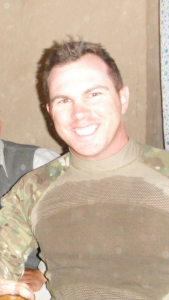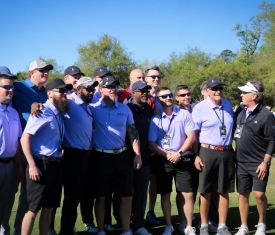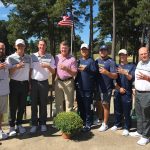by Jack Persons
The Salute Military Golf Association and the George Washington University Men’s Golf Team have come together to create the Warrior Tribute, a season-long campaign to honor all Warrior Golfers. Five veterans actively taking part in SMGA events will have their names and symbols placed on a golf bag that GW players will carry at all of their tournaments this fall. The bravery of these wounded warriors shines through their service to our country, and in how they live their lives today. It is our privilege to share their stories with you.

Kilmartin on deployment
Sometimes, getting better means moving on.
Maj. Robert Kilmartin spent 20 years in the Army and earned countless medals and awards for his service and heroism, but that was a whole lifetime ago. He’s built a fulfilling post-military life, one without wistful feelings or regrets, and the catalyst for change was golf.
“What was incredible about the opportunity of learning how to golf and then hanging out with other SMGA members was the camaraderie and the emotional healing,” Kilmartin explained. “Knowing, ‘Hey, there’s other people maybe as messed up as you are.’ And the big thing is just moving forward.”
The former 82nd Airborne Division member medically retired in 2015, after enduring two improvised explosive device and small arms fire attacks in Afghanistan, which led to injuries in his knees, back, hips, shoulder, and head. He received a Purple Heart for both instances.
Kilmartin knew his afflictions had slowed his life down, as he had fewer ways to channel his energy and focus. He needed a purpose. So he turned to golf.
“For the first couple of years after I got hurt — I got hurt once in [2011] and once in [2012] — golf was that vehicle that got me outside and got my flexibility better, got my timing better,” he said. “The biggest thing was calming down. I had a lot of anxiety, which was awkward for me, I had never had anxiety before. I’d have physical reactions, and golf really helped that.”
Though he still has his limitations, he makes full swings, works out six days a week, and feels much healthier than he ever did before his introduction to golf. Today, he lives in Tampa with his family and attends law school at Stetson University. He’s made a successful transition to veteran life, which he credits the SMGA for, and now he does all he can to help others navigate the jump the same way.
Kilmartin estimates he has introduced at least two dozen wounded veterans to the SMGA’s Warrior Golf Clinics and American Golfer Program, all of whom have been affected positively by their experiences in the organization. Every player now has a purpose, and a few might even be better than Kilmartin on the course.
But how does golf, the world’s slowest sport, help vets, who operated at break-neck speeds before their injuries, feel normalized? It seems like the wrong hobby for soldiers who relied on split-second decisions, intuition, and adrenaline on the battlefield; however, those instincts came from countless sessions of rigorous training. In reality, the minutiae of military life is procedure-oriented, a detail that translates perfectly into learning the game.
“It takes a lot of technical skill and a lot of concentration,” Kilmartin said. “I think a lot of guys who are injured, especially with brain injuries, there’s a lot of anxiety. There’s 1000 things going on in your head at any given moment, and with golf, as you get better at it and more comfortable, you’re able to get over the ball and breathe, and let muscle memory take over.”
He knows the anxiety well, as he suffered traumatic brain injuries from both IED attacks. He also struggled with anger on the golf course as he learned the game. Eventually he found a way to calm his mind, but it took a change in perspective rather than a mastery of the sport.
The SMGA paid for Kilmartin and a few other members to attend Tiger Jam in 2015, an event in support of the Tiger Woods Foundation. While in Las Vegas, Kilmartin had the opportunity to pick Woods’ brain, at a time when Woods was struggling with many of the same injury limitations Kilmartin had. During their conversation, they talked about how to handle failure, laugh at missed shots, and most importantly, accept personal limitations.
“Play within your skillset,” Woods advised Kilmartin. “As you get better, challenge yourself. But if you challenge yourself and you fail, then don’t get pissed off about it.”
With challenges like combat injuries, law school, and as he admitted, not knowing “what I want to be when I grow up,” Kilmartin uses that guidance every day and finds it relevant to anything he does.
The GW team took on their own set of challenges at the Camden Intercollegiate last weekend in honor of Kilmartin. Coach Chuck Scheinost chose junior Logan Lowe to carry the Warrior Tribute bag at the event. After top-10 finishes in his last two tournaments, it was obvious Lowe had a lot of momentum heading into the event, and he did not disappoint. Lowe managed to close the door on the rest of the field, shooting rounds of 68-70-68 to win by a single shot.
“It was an honor to be able to carry the bag, and to pick up a win with it is something I will never forget,” Lowe said. “Picking up a win is always something very exciting, but having the opportunity to represent a hero like Maj. Kilmartin at the same time is amazing. It’s hard to put into words how special this experience was for me. Knowing that I was representing something bigger than myself and the team kept things in perspective for me all day during the final round.”
Lowe put his stamp on the Warrior Tribute project, adding a trophy to honor the sacrifices of every SMGA member. What better way to salute our heroes than by winning?
px; padding:0; width:99.375%; width:-webkit-calc(100% – 2px); width:calc(100% – 2px);”>





